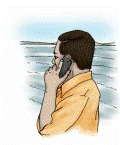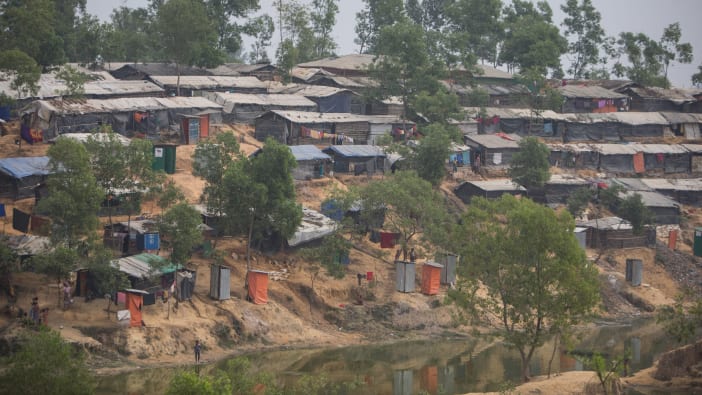In the event of a disaster, warning communities can make the difference between life and death. Below you will find some examples of early warning systems which are useful in areas at risk of flooding. It is important to establish a simple method of monitoring the increase in water depth, so there can be some warning of an approaching flood.

Articles
Early warning systems
In the event of a disaster, warning communities can make the difference between life and death
Available in English, French, Portuguese and Spanish

From: Managing disasters – Footsteps 88
How to prepare for disasters and reduce the risk of them occuring

Illustration by Amy Levene
Depth marker posts
In some countries, communities place a series of bamboo poles in a river, with depth marks (as on a ruler) along the pole. Three colours are often used:
- green at the bottom, meaning ‘safe’
- yellow in the middle, meaning ‘be alert’
- red nearer the top, meaning ‘danger’.
This gives an indication of how quickly the water is rising. During heavy rain, some community members should be given the task of monitoring the water level and warning the community if the water reaches the danger level (marked in red).
Rope and bells
One community in the Philippines ties ropes over the rivers, with flags and small bells attached. If the river level rises, the bells ring, alerting people to the danger.
Lookouts
In some parts of Afghanistan, during the flash flood season a community will send young men to herd goats in the high hills and watch for surges of water in the stream bed. If the lookout sees the water rising quickly, he will alert the community through firing an air rifle, blowing a horn, or another signal that can be heard over long distances.

Illustrations by Amy Levene
Raising the alarm
Once the water has risen above the danger level, all members of the community must be alerted, and those in danger must be asked to move to higher ground. Many communities have developed ways of passing on warnings including using church bells, mosque loudspeakers, mobile phones, gongs and megaphones (carried by volunteers on bicycles). In flash floods, the water rises very quickly. Where mobile phones are working, messages can be passed by mobile from upstream to downstream locations, alerting people to approaching floods.
Community/Group Activity - Putting together an effective early warning system
Please note: this activity could relate to many different hazard types.
Draw a grid on a large sheet of paper or a blackboard.
Ask the group, “What features make an early warning system effective?” Write down all the brainstormed answers in the left hand column of the grid. Suggest any additional features the group may have missed.
Then discuss what kinds of early warning system are available or possible in the community. Write them across the top row of the grid.
For each of the possible early warning systems, go down the column and mark which of the effective features it has. For example, ‘church bells’ might be good at reaching the vulnerable, but people might not know what to do when they hear them. Mobile phones might be good at rapidly spreading the word, but the most vulnerable households might not have a mobile phone.
The finished grid will help the community identify which options will be best in their context. It is rare for a single type of early warning system to be 100% effective. In most cases, some combination will be the best option. For example, a lookout with a mobile phone could call the church or mosque, which could then broadcast the warning so the whole community can hear it.
Types of Early Warning System - left to right across the top
Mobile phones
Church bells (or mosque loudspeaker)
Radio broadcast
Volunteer with megaphone
Features of effective early warning systems - top to bottom down the side
Comes at the right time (relative to the speed of the disaster)
Reaches all people (especially the most vulnerable)
Accurate: communicates the right information
Uses locally available resources and reliable, durable technology
Incorporates traditional knowledge about early warning of disasters
People know what it means, and they know what to do
Not likely to give false alarms
Practised in drills and changed based on feedback from the community
Similarly Tagged Content
Share this resource
If you found this resource useful, please share it with others so they can benefit too.

Subscribe to Footsteps magazine
A free digital and print magazine for community development workers. Covering a diverse range of topics, it is published three times a year.
Sign up now - Subscribe to Footsteps magazine





